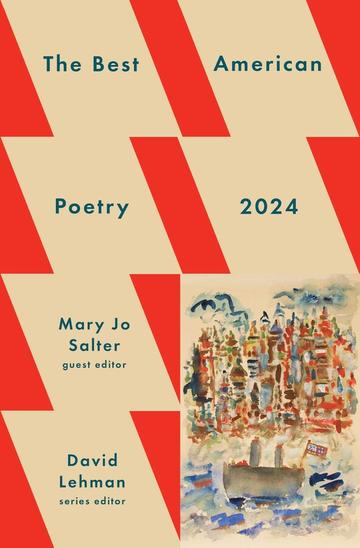Echolocations: Reflections on Poems by A.E Stallings (Issue 3)
'The Best American Poetry 2024', edited by Mary Jo Salter and David Lehman (series editor).

In this new series, A.E. Stallings, Oxford’s Professor of Poetry, will explore a contemporary poem from a new book or anthology or journal and explain what she admires about it. You can subscribe to the newsletter to receive each issue in your inbox. This issue explores The Best American Poetry 2024.
Begun in 1988 with a volume guest-edited by John Ashbery, The Best American Poetry (BAP) series has been running for a startling 36 years and counting, including intercalary volumes such as a Best of The Best of American Poetry (edited by Harold Bloom in 1997), and a 25th anniversary edition (edited by Robert Pinsky). The list of editors is a who’s who of US poetry elites. And behind it all, the poet David Lehman, the series editor, has labored quietly and diligently ensuring its continuity and continued relevance.
As with any annual publication, not to mention one where the volume editor changes each year, the series is inevitably uneven, although the guiding hand of Lehman ensures a certain base-level of quality. Every year will have its new-discovered gems, its duds, its stars, and, often enough, its brief but vitriolic controversies played out across social media. You might think such a long-running series would have played out its initial energies, but I think I can say with some confidence that Mary Jo Salter’s 2024 volume is the best volume in a decade, and arguably the best BAP volume ever produced. (In the interest of full disclosure, I should point out I am also included in this volume; I have been lucky enough to have appeared in BAP many times over the years, beginning with the class of 1994.)
Salter’s volume fizzes with the potential of debut poets, the sprezzatura of journeyman accomplishment, and the depth of old masters. Intriguingly, Salter singles out a number of longer poems for inclusion, I think putting her finger on a recent trend. As the series initially intended, we get a generous survey of what is happening in American poetry today, and a sense of whence (journals) and by whom (poets) the best work is coming. Unlike some prominent American poetry magazines, we also have a sense of the editor’s (Salter’s) idiosyncratic taste and aesthetic, which is wide ranging, but focused on craft rather than, say, identity or political orthodoxy.
OK, I’m not entirely sure what qualifies a poem as being “American” as far as the series is concerned—a couple of the entries are by Canadian poets (the terrific Karen Solie, for instance) and at least one featured publication is UK-based (Bad Lilies). US Poets Laureate are represented (including the current one, Ada Limón), but so is a former UK Poet Laureate, Andrew Motion. A couple of the poets here—Mark Strand and Louise Glück—already lie buried on the slopes of Parnassus. But the book is all the stronger for its broad church. Behind its variety and scope lie Salter’s crackling intelligence and contagious enthusiasm. (I nearly burst out into audible agreement when I read, “It has always felt like Christmas to me when Gjertrud Schnackenberg, for instance, has new work to show.” Indeed!)
I could pick almost any poem at random here to admire—and I might come back to look at more poems from this volume over the next months—but I am going to pick one of its excellent sonnets, Ange Mlinko’s “The Open C”:
The Open C
You stare into it for days, all your life
as if waiting for a curtain to rise. As if
a production of Ariel and Prospero
were pending in the ocean’s void,
the amphitheater of the asteroid.
There’s only shocked quartz below.
Where sky and sea are never parted—
there the mass extinction started.
Now resurface, to the serene
compact of our opening scene:
one blue mirror reflects a poreless face,
dazzling evening’s investigators.
The other, darker, on the case
shows, in close-up, the craters.
One of the pleasures of the series is that it includes brief write-ups of the poems by the poets themselves, and before I say anything about “The Open C,” it is worth seeing whether Mlinko’s hasn’t already beat me to it. (Mlinko is not only one of her generation’s best poets, she is one of its smartest critics.) Of the poem, which appeared in the excellent on-line journal Bad Lilies, Mlinko writes, with typical succinctness:
The Open C was written on St. George Island, on the Florida Gulf Coast. It’s impossible not to gaze at the horizon of the sea without thinking of the Chicxulub Crater. The sonnet plays on the letter C, sea, and what you can and can’t see, including your own face. ‘Compact’ may mean agreement, density, or the little compact with two mirrors. The extinction that awaits may be someone else’s, or may be your own.
Now, if I did not have this information, would I be thinking of the Chicxulub Crater, with its clicking of c’s as well as crashing of seas? Possibly not right away, although “the amphitheater of the asteroid” offers it up, confirmed by the line “There the mass extinction started.” My image was initially of looking at the sea under a moon, with its face, reflections, and craters, a moon that also might sometimes look like a C as it hangs over the sea. “The Open C” intrigues as a title, since it brings the multivalent pun very much to our attention. A cross-section of a crater might, I suppose, look like a C, there is the bowl of the sea, and just maybe there is a C-is-for-cookie-with-a-bite-out-of-it moon.
I am put in mind of another sonnet, by another poet connected with Florida, Donald Justice, who ends a poem (“The Pupil”) about piano lessons in his Depression-era childhood on a musical C/sea pun:
And still to bear on across Chopin or Brahms,
Stupid and wild with love equally for the storms
Of C# minor and the calms of C.
I don’t think Mlinko has this poem consciously in mind. But there is something about her elusive sonnet, at once crystal clear and craftily shifty, that invites this kind of imaginative collaboration with the reader. For instance, my other thought about the “open C” is that it is a string, of, say, the mellow viola, with its rare C Clef. I hear it somehow in the waiting for the curtains to open of the performance of The Tempest (the storms of C# minor?), with an overture by, say, Purcell, whose Full Fathoms Five I am listening to right now.
A sonnet should properly, I think, feel like a grenade, a small container of explosive force. This feels like that. The rhymes are ingeniously wrought (from the slant of life/if to the pleasure of Prospero/below, to the unexpected investigators/craters), but so also the rhyme scheme. (Is this a Mlinko sonnet? AABCCBDD EEFGFG seems original, a new species perhaps, particularly that intricately coiled spring of an octave.)
And there are almost too many figures and sleights of sound here to count. The sea as amphitheater, but also that wonderful “compact”—the compact mirror, for me, dominating, with its upper and lower halves hinged like a sonnet, its private reflections, its retro-glamorous snapping open and shut. The compact is, after all, something of an old-fashioned accessory, what with people now checking their faces in their phones, and has to me something of a film noir aesthetic, a way to adjust one’s lipstick but also check around dark corners, which chimes with “investigators” and even “on the case.” Although of course “on the case” also means here on the carapace of the compact. Talk about compact!
Mlinko’s little sonnet (it feels especially efficient, with its preponderance of trim tetrameter lines), contains worlds and geologic time and Shakespeare and an ominous future and a reflected human face, plunges from outer space, goes deep under the water and resurfaces, and glances at the sky. Phew! Her work also reminds me of something I have been constantly telling aspiring poets over this past year at Oxford: clarity and mystery can coexist.
I should add that this sonnet also appears in Mlinko’s new book, just out with Faber and with FSG, Foxglovewise, a book I also hope to get around to writing about soon. And she has a book of criticism I am eagerly looking forward to, Difficult Ornaments: Florida and the Poets from Oxford University Press. Maybe someone at OUP could send me a review copy (hint, hint)?
aes
Poem reprinted with permission from The Best American Poetry 2024 (Scribner), ed. Mary Jo Salter.
Scribner (September 2024)
Copyright (c) 2024 by Ange Mlinko. All rights reserved.



